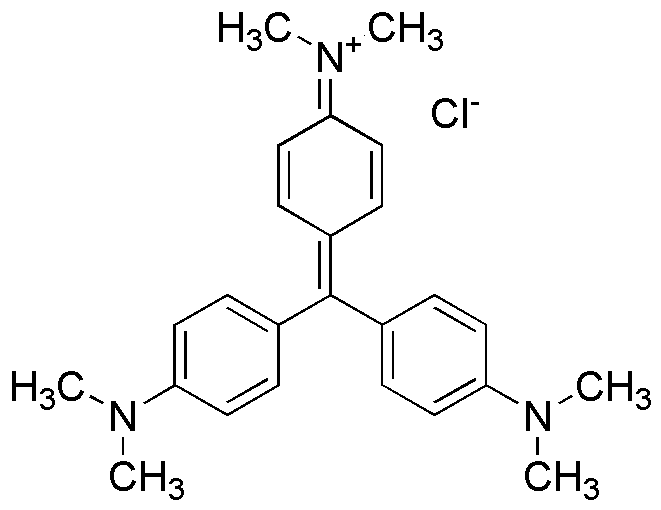Crystal violet is widely utilized in research focused on:
- Biological Staining: Commonly used as a dye in microbiology to stain bacterial cells, making them easier to observe under a microscope. This application is crucial for identifying and classifying different types of bacteria.
- Histology: Employed in histological studies to stain tissue sections, aiding pathologists in diagnosing diseases by highlighting cellular structures and abnormalities.
- Antimicrobial Activity: Investigated for its potential as an antimicrobial agent in various formulations, offering an alternative to traditional antibiotics in treating infections.
- Textile Industry: Used as a dye in the textile industry for coloring fabrics, providing vibrant and long-lasting colors, which is essential for fashion and home décor.
- Research in Cell Biology: Utilized in cell culture studies to track cell division and differentiation, helping researchers understand cellular processes and develop new therapeutic strategies.
General Information
Properties
Safety and Regulations
Applications
Crystal violet is widely utilized in research focused on:
- Biological Staining: Commonly used as a dye in microbiology to stain bacterial cells, making them easier to observe under a microscope. This application is crucial for identifying and classifying different types of bacteria.
- Histology: Employed in histological studies to stain tissue sections, aiding pathologists in diagnosing diseases by highlighting cellular structures and abnormalities.
- Antimicrobial Activity: Investigated for its potential as an antimicrobial agent in various formulations, offering an alternative to traditional antibiotics in treating infections.
- Textile Industry: Used as a dye in the textile industry for coloring fabrics, providing vibrant and long-lasting colors, which is essential for fashion and home décor.
- Research in Cell Biology: Utilized in cell culture studies to track cell division and differentiation, helping researchers understand cellular processes and develop new therapeutic strategies.
Documents
Safety Data Sheets (SDS)
The SDS provides comprehensive safety information on handling, storage, and disposal of the product.
Product Specification (PS)
The PS provides a comprehensive breakdown of the product’s properties, including chemical composition, physical state, purity, and storage requirements. It also details acceptable quality ranges and the product's intended applications.
Certificates of Analysis (COA)
Search for Certificates of Analysis (COA) by entering the products Lot Number. Lot and Batch Numbers can be found on a product’s label following the words ‘Lot’ or ‘Batch’.
*Catalog Number
*Lot Number
Certificates Of Origin (COO)
This COO confirms the country where the product was manufactured, and also details the materials and components used in it and whether it is derived from natural, synthetic, or other specific sources. This certificate may be required for customs, trade, and regulatory compliance.
*Catalog Number
*Lot Number
Safety Data Sheets (SDS)
The SDS provides comprehensive safety information on handling, storage, and disposal of the product.
DownloadProduct Specification (PS)
The PS provides a comprehensive breakdown of the product’s properties, including chemical composition, physical state, purity, and storage requirements. It also details acceptable quality ranges and the product's intended applications.
DownloadCertificates of Analysis (COA)
Search for Certificates of Analysis (COA) by entering the products Lot Number. Lot and Batch Numbers can be found on a product’s label following the words ‘Lot’ or ‘Batch’.
*Catalog Number
*Lot Number
Certificates Of Origin (COO)
This COO confirms the country where the product was manufactured, and also details the materials and components used in it and whether it is derived from natural, synthetic, or other specific sources. This certificate may be required for customs, trade, and regulatory compliance.


